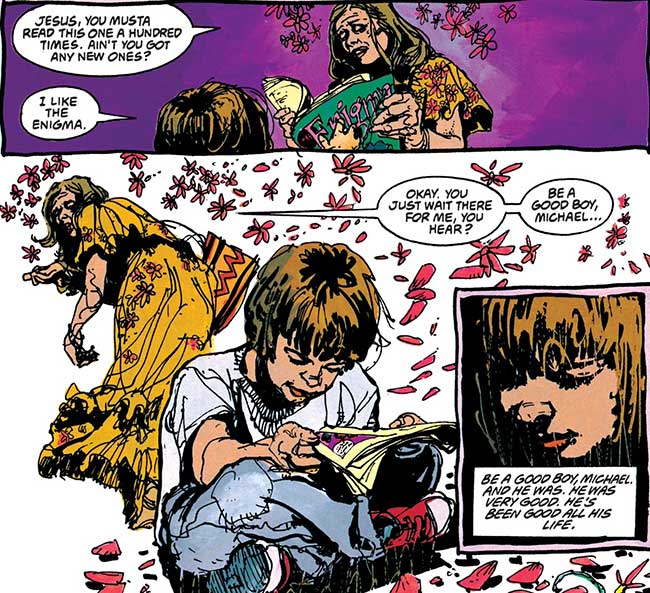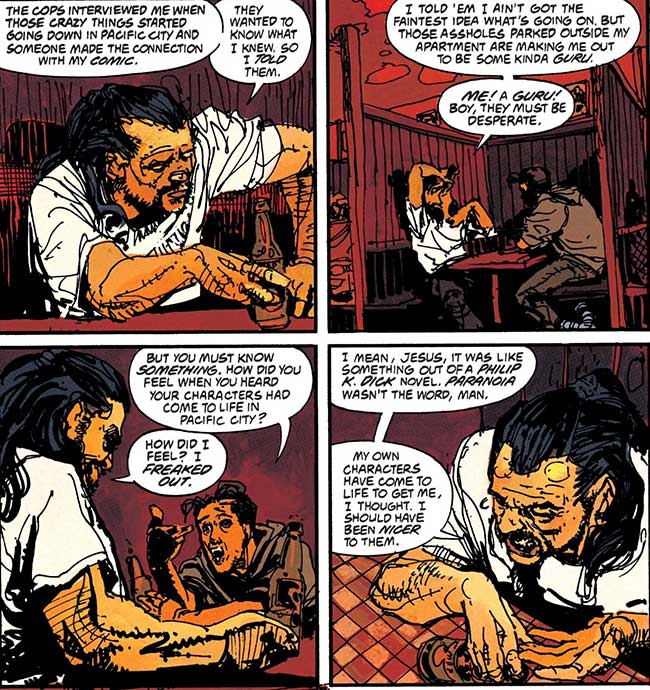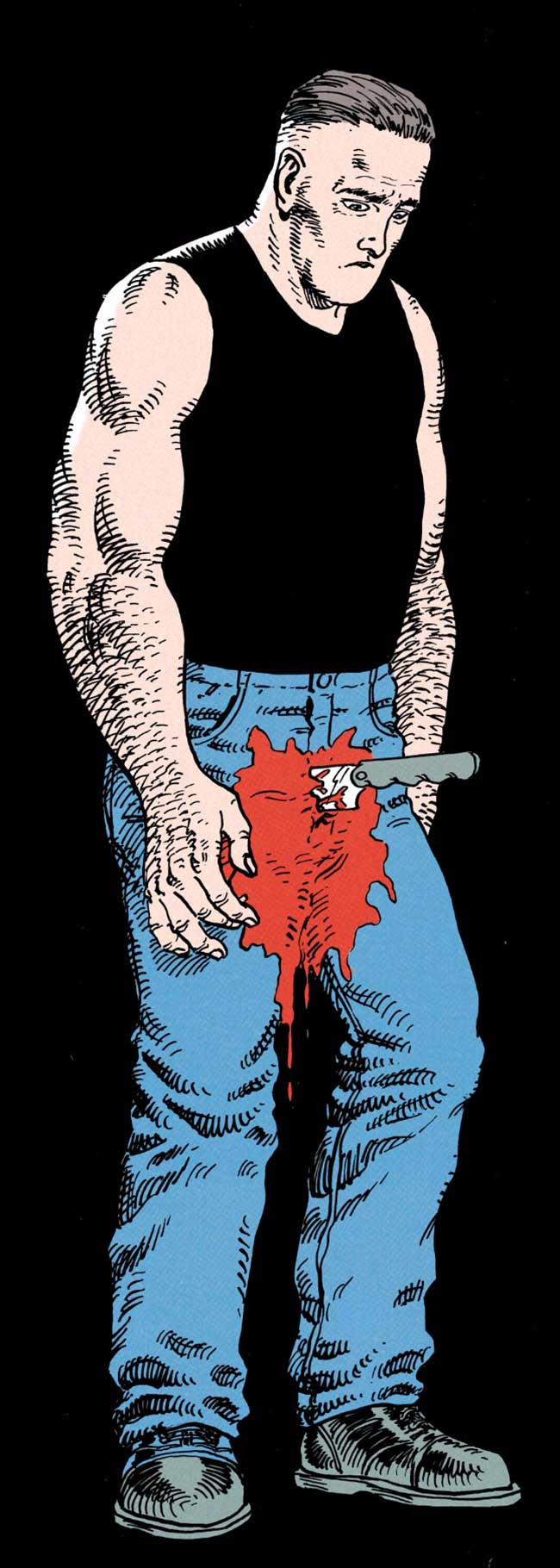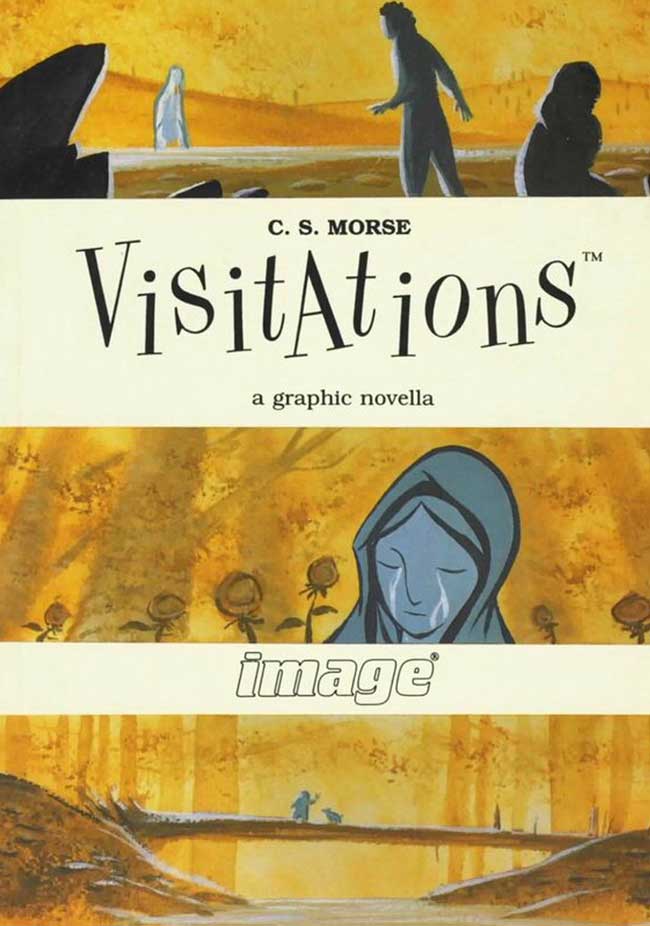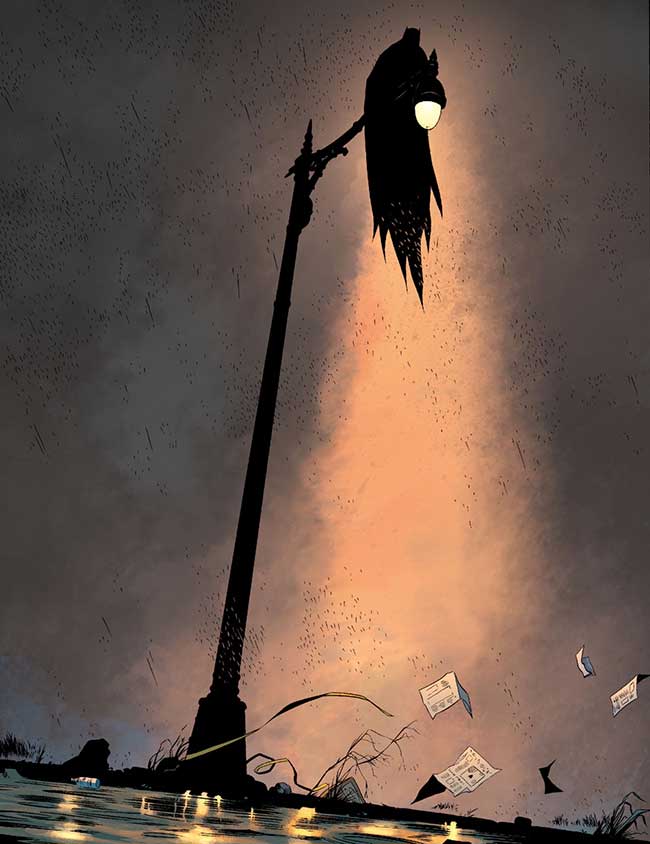Rand Bellavia is back to share his fond memories of decades of comic collecting and reading in this month’s Random Access Memory.
Author’s Note: Random Access Memory is me looking back at the specific comics that shaped my life. Each month I go back in time – in five year intervals – to examine key comics that came out those months. (The idea is that after five years of monthly columns, I will have covered an entire lifetime – in this case, fifty years – of reading comics.) I also list all the comics I read that particular month. This will afford readers the opportunity to chastise me for not reading specific comics, and/or laugh at the horrible, horrible choices I made in the past.
March 1978
Avengers 172
I started reading the Avengers during the year that Hawkeye spent hanging out in the Old West with the Two-Gun Kid, so I was pretty happy to see his return in this issue. I didn’t know much about him, but the sheer volume of hubris and chutzpah that allows a dude with a bow and some arrows to chill with Thor, Iron Man, and Captain America – and then spend most of his time whining that he’s slumming it – just appealed to me.
The main plot of issue involves Hawkeye’s return – which inadvertently leads to the Avengers losing their government priority status – and a big fight between the Avengers and Tyrak. Okay, I need a second. I can’t believe it’s just now occurring to me that the man’s name is Tie Rack. How did that get past an editor? And I thought his buddy Attuma had a terrible name. (Every time he shows up I hear Schwarzenegger’s voice bellowing “It’s not Attuma!”)
At any rate, while all this is happening, the mysterious disappearance of the Avengers continues:

This issue also features a guest appearance from Carol Danvers – then Ms. Marvel – late-70s Marvel’s resident (and, apparently, only) feminist.
Hawkeye and Wonder Man react to her differently, but their lack of comfort is clear. And, even after seeing her in action, Wonder Man can’t help but treat Carol like someone in need of protection.
After the battle, Carol completes the gender inversion by symbolically kissing the girl, mounting her horse, and riding out of town.
The way she cups Wonder Man’s chin in the second panel makes it clear that – as far as she was concerned – he was the damsel in distress the entire time.
And then, just in case you forgot:
And we end the issue with our first real clue regarding what might be going on:
Other Comics I Read From March 1978
- Captain America 222
- Howard the Duck 25
- Incredible Hulk 224
- Marvel Team-Up 70
- Marvel Two-in-One 40
- Ms. Marvel 18
- Peter Park the Spectacular Spider-Man 19
- Power Man and Iron Fist 51
- Uncanny X-Men 111
- What If 9
March 1983
Comics I Read From March 1983
(move along, nothing to see here – and far too much to talk about in March 1988 and 1993!)
- Alien Worlds 2
- Amazing Spider-Man 241, 242
- Avengers 232
- Captain America 282, 283
- Cerebus 48
- Coyote 1
- Green Arrow 2
- Ka-Zar 27
- King Conan 17
- Kull 2
- Omega Men 3
- Peter Parker the Spectacular Spider-Man 79
- Thing 1
- Uncanny X-Men 170
- What If 39
March 1988
Amazing Adventures
This little-known collection is one of the best non-super-hero titles Marvel has ever published. These seven original short stories all fall loosely into the genre of “historical action/adventure.” And they all contain a surprising amount of narrative depth, as well.
The lead story (and the story imaged on the cover), “Solo” – which could have been called “Trigger Warning,” so be advised – is by Chris Claremont and Michael Golden. It is a Valkyre tale whose main plot involves acquaintance gang-rape. The story is far from perfect – note the ridiculously phallic nature of the creatures imaged on the cover. (Did we really need the chin-testicles?) And the grace ultimately offered by the women-turned-Valkyre may be hard to accept – rather than killing her attackers, she first makes her “friend” comprehend the horror of his actions by having him experience the rape from her perspective, then she turns her two other attackers into female infants and gives them to him to raise – but the story’s heart appears to be in the right place, and the fact that it was published in a Marvel comic in the 80s is, well, rather marvelous. (#JoyceCarolOatesSentence)
Two of the stories in this collection were written by J.M. DeMatteis, and both are deserving of a wider audience.
“Pogrom,” illustrated by Val Marerik, is narrated by a man who survived a pogrom as a child by hiding among the corpses of his neighbors. From his hiding space he is forced to watch a man cut off fingers from dead family members.
Years later, he sees the same man dining with his family.
The old man notices him staring, and asks if they know each other.
And then there is this:
“In the Dark Ages…”, written by DeMatteis and illustrated by John Ridgeway, tells of a nameless knight who seeks the Holy Grail. It is clear he has been searching for years and is very tired. He stops to rest in a nameless town where a local priest offers him comfort and conversation.
Further along the way, the knight encounters one of those “None shall pass!” Black Knights that Grail Legends are so famous for having.
Our man defeats the Black Knight and enters a cave to find what he thinks is an angel holding the Holy Grail.
The dying priest points him back to the cave, and the same plain cup they had shared hours before. When next we see the knight, he is exultant.
We then leap forward in time, finding that the knight has taken the priest’s place.
The Bible tells us that where two or three are gathered, there you will find the presence of God. The cover to the antepenultimate issue of Grant Morrison’s Invisibles tells us that when two humans face one another, there you will find the Holy Grail.
Batman: The Killing Joke
This thing. Sure, Brian Bolland’s artwork is great. And the whole “Batman and the Joker are two-sides of the same coin” conceit is neat – and certainly the inspiration for Tim Burton’s take on Batman – but ultimately this doesn’t hold up as well as we all expected it to. While it is certainly one of Alan Moore’s more popular stories, when taken in context of his catalog, The Killing Joke must ultimately be considered a minor work. That being said, this is Alan Moore we’re talking about, so there is still a lot to unpack and much that is worthy of examination.
There are two narratives at work in this story. In the present, the Joker has broken out of Arkham Asylum yet again, and sets out to show Batman that all it takes is one bad day to drive anyone insane. He chooses Commissioner Gordon as his victim, and rather famously paralyzes Barbara “Batgirl” Gordon in the process.
(I don’t know if this is ground zero for the whole “girls in refrigerators” thing, but Moore really should have known better than to dispose of Barbara in such a callous manner. While it’s tempting to note that this story allowed us to have all those great Oracle stories, and provided a representational female hero for the physically disabled, I can’t overlook how many times I’ve read that when Moore asked permission to paralyze Barbara, his editor’s response was “cripple the bitch.”)
At any rate, intertwined with this story is a flashback showing the Joker’s “One Bad Day.” Or is it?
And they fight. As they fight, the text displayed quotes Batman from the beginning of the book, when he visited the Joker in Arkham.
While they fight, a few very specific details are made clear. Note the Joker trying to attach the spike that administers his deadly Joker venom – which makes the victim laugh himself to death – and the close-up panel of Batman kicking it away.
Now, note that as Batman stops the Joker from stabbing him, he’s clearly looking at something in his hand before he punches the Joker.
After subduing the Joker, Batman makes one last effort to save him. The Joker says it’s too late for that, and then tells Batman a joke. The Joker starts laughing. Batman joins in. And curtain.
When I first read this, I took it at face-value: the Joker was right, he and Batman aren’t all that different, and their chilling laughter should make us all afraid. But if you look more closely, you’ll note that as the sound of the police siren grows, the laughter suddenly stops. While on Kevin Smith’s “Fatman on Batman” podcast, Grant Morrison suggested that in the fifth panel of that page, Batman is reaching up to snap the Joker’s neck. Perhaps. But I think Bolland (or Moore, I haven’t read the original script) wants us to think that Batman may have injected the Joker with his own poison. Either way, you have to admit that it makes sense for a story that opens and closes with a conversation about how Batman is worried that his relationship with the Joker can only end in one of them killing the other – and, let’s not forget, is called “The Killing Joke” – to end with Batman killing the Joker.
Question 17
As any comic book nerd can tell you, the characters from Alan Moore and Dave Gibbons’ Watchmen were originally meant to be the characters DC has recently purchased from Charlton Comics. Making the shrewd financial decision *not* to kill half the characters they had just paid so much money for, DC asked Moore and Gibbons to create analogue characters for Watchmen, and added the Charlton characters (most notably Blue Beetle, Captain Atom, and the Question) into the DC universe shortly after the publication of Watchmen.
Currently, the Watchmen characters are being folded into the DC universe as well, but this issue of the Question appears to be the first official cross-over between the two universes.
We open with the Question on a plane with some familiar reading material.
Rorschach is, of course, the character Moore and Gibbons created to replace the Question. Writer Denny O’Neill put the character through some major changes during this series. Seventeen issues in, he is unrecognizable from the character who inspired Rorschach. Yet he is still capable of being seduced by the character’s no-nonsense black and white moral code.
Later on, the Question asks himself WWRD?
The answer to his question being: Get knocked out.
The Question begins to think he may have chosen his role-model foolishly.
Eventually, he comes back around, but it may be too late.
Luckily, Green Arrow happened to be in the neighborhood. But that’s a story for the next issue.
Other Comics I Read from March 1988
- Black Panther 1
- Cerebus 108
- Crossroads 1
- Dreadstar 37
- Forever People 6
- Hand of Fate 2
- Hellblazer 7
- Hexbreaker
- Incredible Hulk 345
- Justice League International 15, Annual 2
- Man of War 3
- Martian Manhunter 3
- Neat Stuff 10
- Phantom 2
- Scout: War Shaman 1
- Sonic Disruptors 6
- Swamp Thing 74
- Wasteland 7
- Web of Spider-Man 40
- The Weird 4
- Yummy Fur 9
March 1993
Enigma 3
The omniscient narrator of Enigma has a tone that will either drive you crazy or make you fall in love with this comic. I leave it to you to determine which you are:
In this issue we flash back to when our protagonist Michael Smith was a child, and his favorite comic book was The Enigma.
We quickly ascertain that we are also reading Michael’s origin story.
In the present, we follow Michael as he gets to know Titus Bird, the creator of the Enigma comic he so loved as a child.
Titus is as freaked out by the Enigma coming to life as everyone else.
As their conversation winds down, Michael learns one more thing about Titus.
Michael violence response to Titus’ come on was controversial at the time – as was Titus’ apology afterword. It is important to note that it was intended to be controversial, and – as the rest of the story unwinds – it is an important scene. Titus’ sexual identity – and, eventually, Michael’s and the Enigma’s – are key elements in the story. So, hang in there.
Hellblazer 65
It’s easy to dismiss Garth Ennis as a writer a bit too in love with the off-color joke and the ol’ ultraviolence, but there are good reasons that he is rightly considered one of the best comic book writers of all time. One of them is his ability to create very masculine stories (stories about male comradery, what it means to “be a man” in the modern world, etc.) while also populating his tales with strong, three dimensional women with genuine agency.
An early example of this was Hellblazer’s Kit Ryan. Dating John Constantine isn’t easy, or particularly safe. In this story, John yet again pisses off the wrong guy, who dispatches two goons (fresh from a Guy Ritchie casting session) to send a message to John.
Kit’s initial response to someone violently breaking into her home is to be expected, but note the shift that takes place in the space of one panel. We see the back of her head as she wonders aloud what is happening, but as the camera swings around, we see resolve in her face as she utters the single word, “Right.”
And it turns out she is more than capable of defending herself, as she punches the larger man in the balls, and makes short work of his companion.
This scene not only establishes that Kit is not to be messed with, but it also gives Ennis and artist Steve Dillon the opportunity to demonstrate one of the unique story-telling methods that comics offers, as we pull back and reveal that Kit wasn’t just punching the guy in the nards, but rather stabbing him with the knife she had grabbed from the kitchen sink. This reveal would be clumsy on film, and near impossible to pull-off in prose in a satisfying manner.
Importantly, Kit’s response to these events is to immediately break up with John and move back to Ireland. This is, of course, an entirely rational response to external stimuli. And it’s not a matter of her being scared so much as a matter of John failing to hold up his end of the bargain by keeping that sort of shit away from her.
Ren and Stimpy Show 6
This is a great issue of a pretty reliably funny comic series. Before he broke into mainstream super-hero comics in the early 21st century, Dan Slott spent the 90s writing funny books like Ren and Stimpy. That makes this issue the first time Slott ever wrote Spider-Man! And he wastes no time in pointing how the early 90s were not kind to Spider-Man’s legacy.
The whole comic is entertaining, but the best sequence by far is the “Spidey needs to dig deep to find the inner-strength to defeat his enemies” sequence.
And just when you thought Stan Lee had to be the punch line…
And the man himself told me that that Otto Flippa joke was not in his original script. Slott just told artist Mike Kazaleh to “go nuts” and draw whatever zany stuff popped into his head for a few panels. He delivered a dude with an upside-down car for a head, and Slott ran with it.
But the real punch line comes after Spidey manages to free himself:
Comics I Read from March 1993
- 1963 1
- Animal Man 59
- Cerebus 168
- Darker Image 1
- Death: The High Cost of Living 3
- Flash 76
- Grendel: War Child 8
- Hate 12
- Incredible Hulk 404
- Kid Eternity 1
- Maxx 1
- Mercy 1
- Sandman 49
- Sandman Mystery Theater 2
- Shade the Changing Man 35
- Spawn 9
- Spectacular Spider-Man 200
- Swamp Thing 131
- X-Factor 90, Annual 8
March 1998
Preacher 37
Preacher has a lot going on, and a lot going for it. So much so, that often the solid craftsmanship that went into the writing, art, and storytelling is often underpraised, if not ignored entirely. One such aspect is how many great (and unexpected) ways Garth Ennis finds for Jesse to use the Word. One example would be when a gun was aimed at Jesse and he simply said, “Miss.” This issue produced an equally powerful moment.
As this wordless page makes clear, Cassidy catches Jesse as he is falling out of an airplane. Now, Cassidy is a vampire, and therefore has more than enough strength to hold Jesse, and get him back into the plane. However, as previously stated, Cassidy is a vampire. And it’s daytime. So, in reaching out to save Jesse, he immediately starts to burn in the sun.
It’s worth pointing out that at this point in the story Cassidy is in love with Tulip – Why can’t he find a woman like that? – and letting Jesse go would not only prevent him from exploding in the sun, but would also (in his mind, at least) greatly increase his chances with her. But he won’t let go. Enter the Word.
Visitations
Scott Morse was a wildly prolific graphic novelist from the late 90s through the mid 2000s. In that time he produced 10 original graphic novels, as well as mini-series work for both Marvel (Elektra) and DC (Catwoman and a great Jim Gordon one-shot). In the late 2000s he produced a series of children’s books based on his Magic Pickle graphic novel. I presume he’s working full-time in animation these days.
Visitations is my favorite of his original graphic novels. It certainly lacks the sense of fun and adventure that marks most of his work, but this one really works on an emotional level.
The story is fairly simple: a priest enters his sanctuary to unexpected find a woman there. She is obviously distressed. They talk. In an attempt to comfort her, he grabs the day’s newspaper…
He reads her the first story and, predictably, he sees the hand of God where she sees random circumstance.
The second story he reads results in a similar conversational stalemate.
When she hears the third article, about a little boy who was shot and killed by a hunter, she bursts into tears.
She pulls a gun out of her purse and holds it to her heard, but something stops her.
And we end with one of the most emotionally powerful two page spreads in the history of comics:
So much to love here. I love that the priest doesn’t hear the boy. Be it miracle or illusion, it is for her alone. I love that single blank panel. And I love that the priest – having no idea what’s happening – doesn’t ask her what she sees or hears. He doesn’t talk about God or miracles. He doesn’t speak at all. He just gets down on the ground and holds her. He comforts her. Two humans facing one another. The Holy Grail.
Other Comics I Read from March 1998
- Avengers 4
- Captain America 5
- Cerebus 228
- Flash 137
- Hellblazer 125
- Hitman 26
- Invisibles 15
- JLA 18
- JLA: Year One 5
- Kurt Busiek’s Astro City 13
- Mage 6
- Starman 45
- Stormwatch 5
- Superman Adventures 19
- Transmetropolitan 9
March 2003
Fantastic Four 67
Mark Waid and Mike Wieringo’s Fantastic Four run was justly praised. It was fun and smart, and – until Jonathan Hickman got his hands on the book – the last time anyone seemed to really get what the book should be about. But this issue took things to a whole other level, offering a slice of genuine horror.
The issue was a prelude to their big Doctor Doom arc, and never has Doom seemed more frightening. We open with Doom consulting a medium, and we learn that Doom has been pining for a lost love.
We learn that early in his life, Doom studied both the sciences and the dark arts, with Valeria by side the entire time.
After a long and difficult search, Doom finds Valeria.
Having won her over, Valeria accepts Doom’s gift.
We quickly learn that the mistake Doom sought to correct was not rejecting Valeria but rather rejecting magic.
As if that wasn’t horrifying enough, we end with a shot revealing that Doom’s new magical armor is made from the flesh of his one true love.
And that, my friends, is how you write a super-villain.
Other Comics I Read from March 2003
- Alias 20
- Amazing Spider-Man 51
- Avengers 65
- Batman 613
- Blood and Water 1
- Captain America 10, 11
- Catwoman 17
- Daredevil 45
- Detective Comics 780
- Flash 196
- Global Frequency 6
- Gotham Central 5
- Hawkman 13
- Hellblazer 182
- Hellblazer: Lady Constantine 4
- Hulk/Wolverine: Six Hours 4
- Incredible Hulk 51
- Invincible 3
- JSA 46
- Lucifer 36
- New X-Men 138
- Powers 30
- Promethea 25
- Punisher 23
- Reload 1
- Sleeper 3
- Truth: Red, White, and Black 5
- Ultimate Spider-Man 37, 38
- Ultimate X-Men 30, 31
- Unstable Molecules 3, 4
- X-Statix 9
- Y: The Last Man 9
- Zero Girl: Full Circle 5
March 2008
All-Star Superman 10
It would be hard to argue that there is a better Superman story than Grant Morrison and Frank Quitely’s All-Star Superman, and this is probably the best single issue of the 12-issue series.
At the beginning of the series, Lex Luther poisons Superman with an overdose of solar radiation, so Superman spends the series knowing that he is dying. This is the issue where it all comes to a head. He spends most of the issue racing time to complete various tasks before his death. Some tasks are large – like finding a way for the citizens of the bottled city of Kandor to live a normal life. Other tasks are small – showing how, even with time running out at the worst moment of his life, Superman values the life of a stranger above all else.
This is the most famous page from All-Star Superman, and perhaps the most famous comic book page of the 21st century. And rightly so. It expresses everything you need to know about Superman in five panels.
Interestingly, if you blow up two panels from a previous page – where Superman is shown performing several heroic tasks, like preventing a monorail accident – we see Regan’s doctor frantically calling her.
It can be inferred that Superman overheard this conversation, and – feeling partially responsible for the doctor’s delay – took it upon himself to check in on Regan.
But the primary task Superman undertakes in this issue is attempting to learn if the world could live without him. In pursuit of this information, he conducts an elaborate experiment.
As the issue progresses – and Superman conducts heroic task after heroic task – we occasionally check in on Earth Q’s oddly familiar development. Here we see Giovanni Pico della Mirandola, a philosopher from the Italian Renaissance.
And German Existentialist Friedrich Nietzsche:
Finally, we find ourselves in Joe Shuster’s Cleveland apartment in the late 1930s:
So, we learn two things:
- A world without Superman would inevitably have to create him
- Superman is, quite literally, God Almighty, the creator of our world
Other Comics I Read from March 2008
- 100 Bullets 89
- Action Comics 866
- Amazing Spider-Man 552-554
- Avengers: Initiative 11
- Batman 675
- Booster Gold 7
- Brave and the Bold 11
- Captain America 36
- Cassanova 12
- Criminal 2
- Crossing Midnight 17
- Daredevil 106
- Detective Comics 842
- DMZ 29
- Ex Machina 35
- Exterminators 27
- Fantastic Four 555
- Ghost Rider 21
- Goon 22
- Green Lantern 29
- Hellblazer 242
- Immortal Iron Fist 13
- Incredible Hercules 115
- Infinity, Inc. 7
- Invincible 49
- JSA 14
- Justice League: New Frontier Special
- Kick-Ass 2
- Logan 1
- Loveless 23
- Mighty Avengers 10, 11
- New Avengers 39
- Nightwing 142
- Northlanders 4
- Order 9
- Pax Romana 2
- Palookaville 19
- Powers 28
- Programme 9
- Punisher 55
- Punisher War Journal 17
- Scalped 15
- She-Hulk 27
- Thor 7
- Thunderbolts 119
- Tiny Titans 2
- Transhuman 1
- Ultimate Human 3
- Ultimate Spider-Man 120
- Uncanny X-Men 496
- Walking Dead 47
- War is Hell: The First Flight of the Phantom Eagle 1
- Wolverine 63
- World War Hulk Aftersmash: Warbound 4
- X-Factor 29
March 2013
Batman and Robin 18
This requiem issue takes place just after the death of Damian Wayne, aka Robin. It is a silent issue made up mostly of moody full-page splashes of Batman brooding. The visual story-telling is clear, and emotionally, the entire issue is pitch-perfect. The emotional highlight is when Bruce discovers the letter Damian wrote him before escaping his home to help Batman fight Leviathan – an act that lead to his death.
The final shot, of Bruce cradling Damian’s Robin costume, is fitting.
But, the real star of the show this issue is colorist John Kalisz. The pages employ a shifting color palette, yet they all fit and flow together quite naturally. Note the subtle use of color throughout this page:
And check out the red, orange, and yellow hues on this page:
And if you ever wondered how much coloring can change the mood of comic art, note that this page and the cover are essentially the same illustration.
Other Comics I Read from March 2013
- Action Comics 18
- Age of Ultron 1-3
- All-New X-Men 8, 9
- Animal Man 18
- Aquaman 18
- Avengers 7, 8
- Avengers Assemble 13
- Batman 18
- Batman Incorporated 9
- Bedlam 5
- Blackacre 4
- Captain Marvel 11
- Change 4
- Chew 32
- Comeback 5
- Daredevil 24
- Daredevil: End of Days 6
- East of West 1
- Fantastic Four 5
- Fatale 13
- FF 5
- Five Weapons 2
- Fury Max 10
- Great Pacific 5
- Green Arrow 18
- Green Lantern 18
- Guardians of the Galaxy 1
- Indestructible Hulk 5
- Invincible 101
- Iron Man 7
- Justice League 18
- Justice League Dark 18
- Justice League of America 2
- Manhattan Projects 10
- Mara 3
- New Avengers 4
- Nowhere Men 4
- Planetoid 5
- Powers: Bureau 2, 3
- Revival 8
- Saga 11
- Snapshot 2
- Superior Spider-Man 5, 6
- Swamp Thing 18
- Thor: God of Thunder 6
- Time Warp
- Uncanny X-Men 3
- Walking Dead 108
- Where is Jake Ellis? 3
- Winter Soldier 16
- Wolverine and the X-Men 26, 27
- Wonder Woman 18
- X-Factor 253
- Young Avengers 3
Dear Spoilerite,
At Major Spoilers, we strive to create original content that you find interesting and entertaining. Producing, writing, recording, editing, and researching requires significant resources. We pay writers, podcast hosts, and other staff members who work tirelessly to provide you with insights into the comic book, gaming, and pop culture industries. Help us keep MajorSpoilers.com strong. Become a Patron (and our superhero) today.


































